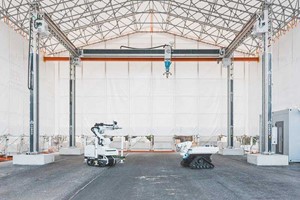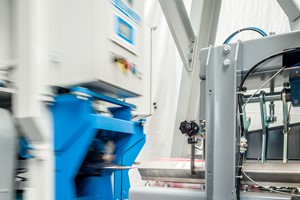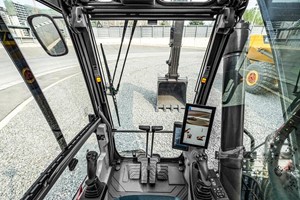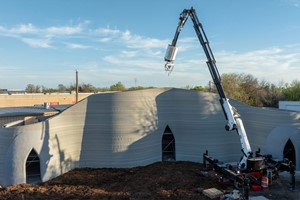TU Braunschweig is embarking on an ambitious endeavor to revolutionize the construction industry with its project titled "The Digital Construction Site – Construction Industry 4.0 as the Key to a Digital and Sustainable Construction Industry." Spearheaded by five professors, the initiative aims to explore the integration of digital production technologies into real construction site conditions, paving the way for a more efficient, sustainable, and technologically advanced construction sector.
At the heart of this initiative lies a cutting-edge research infrastructure on Beethovenstraße, situated on the East Campus of TU Braunschweig. This infrastructure comprises various digitally controlled large-scale devices, including robotic units, a mobile robot, an automated concrete mixing plant, object tracking systems, and immersive technologies such as an LED wall with virtual reality capabilities. The centerpiece of this facility is a towering six-meter-high "3D printing unit," designed to produce large-format, individualized components additively, layer by layer, using advanced 3D concrete printing technology.
Professor Patrick Schwerdtner from the Institute of Construction Management and Construction Operations underscores the significance of additive manufacturing technologies, particularly 3D concrete printing, in transforming the construction industry. By eliminating the need for formwork and optimizing material usage, these technologies promise economic, ecological, and social benefits. Moreover, automation enhances occupational safety by reducing manual labor in challenging conditions.
Collaborating with TU Munich in the Collaborative Research Center TRR 277 "Additive Manufacturing in Construction" (AMC), TU Braunschweig aims to bridge the gap between basic research and practical application. The digital construction site serves as a real-world testbed for exploring the scalability and applicability of research findings. By integrating various digital technologies and embracing the principles of Industry 4.0, the project seeks to establish a seamless digital process chain from planning to production and assembly, thereby enhancing resource efficiency, reducing construction time, and minimizing errors through data-driven communication.
The "Digital Engineering Center" acts as the nerve center of the production process, consolidating information from the digital construction site into a three-dimensional Building Information Modeling (BIM) model. This model serves as a visual collaboration tool, allowing stakeholders to synchronize schedules, analyze processes, and exchange data efficiently. Additionally, the center doubles as a virtual reality laboratory, facilitating the projection of digital components into real space for enhanced visualization and analysis.
Quality control is paramount in construction, and the project incorporates state-of-the-art technologies for monitoring and assurance. The digitally controlled concrete mixing plant for 3D printing enables precise control over material production, ensuring the printed structures adhere to specified geometries and quality standards. Furthermore, automatic 3D surveying sensors and tracking systems enable real-time monitoring of construction progress, weather conditions, and structural integrity, facilitating timely interventions and adjustments.
Looking ahead, TU Braunschweig envisions the digital construction site as a model for future construction infrastructure. By engaging regional and national industry partners, the project seeks to foster collaboration and knowledge exchange, driving innovation and shaping the future of the construction sector. Professor Schwerdtner emphasizes the importance of early engagement with emerging technologies, urging planning offices and construction companies to integrate these considerations into their strategic planning processes.
In summary, the project "The Digital Construction Site" represents a significant step towards realizing a digital and sustainable construction industry. Through interdisciplinary collaboration, cutting-edge research, and industry engagement, TU Braunschweig aims to chart a path towards more efficient, resource-conscious, and technologically advanced construction practices. With funding from the European Regional Development Fund and support from the Lower Saxony Ministry of Science and Culture, the project is poised to make a lasting impact on the future of construction.
Expanding further, this initiative holds immense promise not only for academic research but also for practical application and industry adoption. By leveraging digital technologies and embracing a holistic approach to construction, stakeholders stand to benefit from increased efficiency, reduced environmental impact, and enhanced safety across the entire construction lifecycle.
One of the key advantages of additive manufacturing technologies, such as 3D concrete printing, lies in their ability to eliminate the need for traditional formwork. This not only streamlines the construction process but also reduces costs associated with material waste and labor. By precisely depositing material only where needed, additive manufacturing minimizes resource consumption, contributing to a more sustainable construction industry.
Furthermore, the integration of robotics and automation improves safety by reducing reliance on manual labor in hazardous conditions. With robotic units and automated systems handling tasks that were previously performed by hand, workers are less exposed to risks associated with construction sites, particularly in adverse weather conditions or challenging environments.
The collaboration between TU Braunschweig and TU Munich in the Collaborative Research Center TRR 277 "Additive Manufacturing in Construction" exemplifies the importance of interdisciplinary research in driving innovation. By pooling expertise from various fields, researchers can tackle complex challenges and develop solutions that are both scientifically rigorous and practically applicable. Through joint efforts, insights gained from basic research can be translated into real-world applications, accelerating the adoption of emerging technologies in the construction industry.
The establishment of the "Digital Engineering Center" as a central hub for information exchange and collaboration underscores the project's commitment to harnessing digital tools for enhanced productivity and communication. By utilizing Building Information Modeling (BIM) and virtual reality technologies, stakeholders can visualize construction processes, identify potential bottlenecks, and optimize workflows in real time. This not only improves decision-making but also fosters a culture of transparency and accountability throughout the project lifecycle.
Quality control is another area where digital technologies play a transformative role. With advanced sensors and tracking systems, researchers can monitor construction progress, detect deviations from planned geometries, and assess structural integrity with unprecedented accuracy. By leveraging data-driven insights, construction teams can proactively address issues and ensure compliance with quality standards, ultimately delivering better outcomes for all stakeholders involved.
Looking ahead, the digital construction site at TU Braunschweig serves as a beacon of innovation for the construction industry. By demonstrating the feasibility and benefits of digital production technologies in real-world settings, the project sets a precedent for future developments in construction practice and infrastructure. Through ongoing collaboration with industry partners and continued investment in research and development, TU Braunschweig aims to catalyze a paradigm shift towards a more digital, sustainable, and resilient construction industry for the 21st century and beyond.
By Lucia Gartner













